Achema (www.achema.de), the global forum for the chemical engineering and process industries presented by Dechema e.V. (www.dechema.de), is taking place August 22–26 in Frankfurt am Main, Germany. This year’s event will feature over 2,000 exhibitors and a comprehensive technical program. The Achema Technical Congress will bring together thought leaders and technology experts to discuss important topics, including: the hydrogen economy; laboratory and analytics advancements; bioprocessing; and much more. This year, several co-located events will expand the breadth of topics, including: Climate-Neutral Chemical Industry 2050; Automation in Dialog; the International Powder and Nanotechnology Forum (IPNF) 2022; and more. This show preview covers a small selection of the products and services of Achema’s exhibitors.
Faster battery processing with this powder-dispersion system
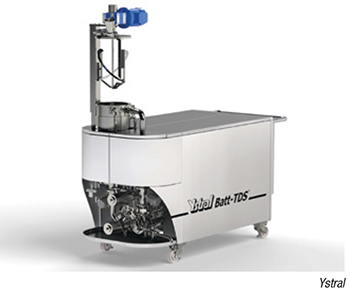 BATT-TDS (photo) is a new powder-dispersing system that enables quick mixing of electrode slurries used in the manufacture of lithium-ion batteries. The system is said to reduce the time required for the production of electrode slurries from around 2–6 h to just a few minutes. The system inducts powders dust-free under vacuum into a stream of liquid, thereby creating conditions for optimal dispersion of diverse components in a continuous sequence. Independent control of key parameters, including flow and shear rates, offers a wide process window. Hall 12.0, Stand C68 — Ystral GmbH, Ballrechten-Dottingen, Germany
BATT-TDS (photo) is a new powder-dispersing system that enables quick mixing of electrode slurries used in the manufacture of lithium-ion batteries. The system is said to reduce the time required for the production of electrode slurries from around 2–6 h to just a few minutes. The system inducts powders dust-free under vacuum into a stream of liquid, thereby creating conditions for optimal dispersion of diverse components in a continuous sequence. Independent control of key parameters, including flow and shear rates, offers a wide process window. Hall 12.0, Stand C68 — Ystral GmbH, Ballrechten-Dottingen, Germany
New gear pumps and control systems for low-viscosity fluids
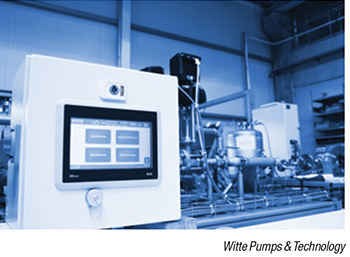 The new CoreCommand gear pump is a dosing pump for low-viscosity media in applications where high pressure and a wide temperature range are required. The pump also features a two-stage pump system, which is an unusual feature in typical gear pumps. The system is suitable for building up a comparatively high pressure with low-viscosity media. The CoreCommand range also includes a pump control system (photo) that can be easily integrated into existing processes. Operation is carried out via a touch-sensitive, 7-in. panel. The control system is housed in a small control cabinet that complies with industrial standards. Due to the control panel’s small dimensions, it can be flexibly positioned near the pump. Hall 8.0, Stand F38 — Witte Pumps & Technology GmbH, Tomesch, Germany
The new CoreCommand gear pump is a dosing pump for low-viscosity media in applications where high pressure and a wide temperature range are required. The pump also features a two-stage pump system, which is an unusual feature in typical gear pumps. The system is suitable for building up a comparatively high pressure with low-viscosity media. The CoreCommand range also includes a pump control system (photo) that can be easily integrated into existing processes. Operation is carried out via a touch-sensitive, 7-in. panel. The control system is housed in a small control cabinet that complies with industrial standards. Due to the control panel’s small dimensions, it can be flexibly positioned near the pump. Hall 8.0, Stand F38 — Witte Pumps & Technology GmbH, Tomesch, Germany
This versatile radar sensor offers safety and security
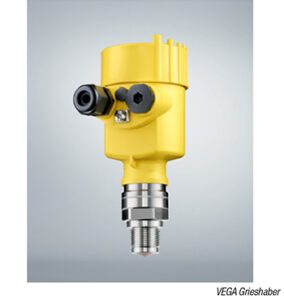 VegaPuls 6X (photo) is a radar sensor that can measure level in nearly any application. The sensor features a new radar-chip technology and a self-diagnosis system that immediately detects damage or interference, ensuring higher availability and safety. In addition to SIL certification, the matter of cybersecurity is fully taken into account through compliance with security standard IEC 62443-4-2, which specifies the strictest requirements for secure communication and access control. Hall 11.1, Stand C63 — VEGA Grieshaber KG, Schiltach, Germany
VegaPuls 6X (photo) is a radar sensor that can measure level in nearly any application. The sensor features a new radar-chip technology and a self-diagnosis system that immediately detects damage or interference, ensuring higher availability and safety. In addition to SIL certification, the matter of cybersecurity is fully taken into account through compliance with security standard IEC 62443-4-2, which specifies the strictest requirements for secure communication and access control. Hall 11.1, Stand C63 — VEGA Grieshaber KG, Schiltach, Germany
Use these plasticizers where durability is a must
Elatur DinCD is a new family of plasticizer for durable products. The new product, a cyclohexanoate, is characterized by a combination of performance properties, such as low-temperature flexibility, and high ultraviolet (UV) resistance, thus contributing significantly to the weather resistance and durability of the products made from it. Due to its low viscosity, Elatur DinCD is easily processed and is suitable for demanding interior and exterior applications, such as textile fabrics, roofing membranes, floor coverings, adhesives and sealants, as well as paints and coatings. The new product is to be manufactured in Marl, Germany. Hall 9.1, Stand D66 — Evonik Industries AG, Essen, Germany
Flexible ozone-generation system adapts to fluctuating conditions
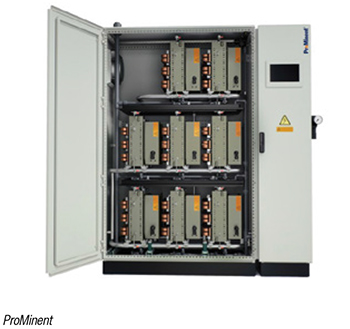 Ozone is increasingly being used to eliminate as many pollutants as possible from wastewater. Ozone breaks down trace substances through oxidation or converts them into smaller molecules. They are then easier for micro-organisms to break down in a post-treatment stage or can be removed by means of absorption. Making ozone generation as cost-effective as possible is not easy, because ozone quantities vary greatly due to the huge fluctuations in wastewater quantities and the composition of trace elements. The Dulcozon OZLa is a new ozone system (photo) that can be fitted with up to 16 ozone-generator modules. The modules can be activated and deactivated as required. The amount of ozone produced can therefore be adapted to fluctuations, for example in a clarification plant where varying volumes of wastewater are treated. Hall 8.0, Stand J94 — ProMinent GmbH, Heidelberg, Germany
Ozone is increasingly being used to eliminate as many pollutants as possible from wastewater. Ozone breaks down trace substances through oxidation or converts them into smaller molecules. They are then easier for micro-organisms to break down in a post-treatment stage or can be removed by means of absorption. Making ozone generation as cost-effective as possible is not easy, because ozone quantities vary greatly due to the huge fluctuations in wastewater quantities and the composition of trace elements. The Dulcozon OZLa is a new ozone system (photo) that can be fitted with up to 16 ozone-generator modules. The modules can be activated and deactivated as required. The amount of ozone produced can therefore be adapted to fluctuations, for example in a clarification plant where varying volumes of wastewater are treated. Hall 8.0, Stand J94 — ProMinent GmbH, Heidelberg, Germany
High-performance alloys for aggressive conditions
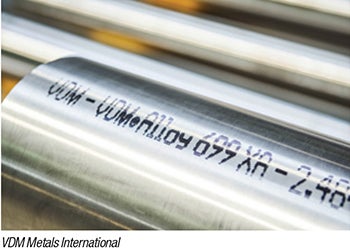 This company provides alloys that are designed for the chemical process industries, particularly for high-temperature applications in combination with aggressive corrosive conditions. The new Alloy 699 XA (photo) offers well-balanced metal-dusting resistance, as well as excellent processability and weldability, says the company. The alloy also features favorable thermal-mechanical properties and microstructure stability. It is offered in various product forms, including bars, sheets, plates, wires, welding rods, powder and seamless tubes. Hall 11.1, Stand C59 — VDM Metals International GmbH, Werdohl, Germany
This company provides alloys that are designed for the chemical process industries, particularly for high-temperature applications in combination with aggressive corrosive conditions. The new Alloy 699 XA (photo) offers well-balanced metal-dusting resistance, as well as excellent processability and weldability, says the company. The alloy also features favorable thermal-mechanical properties and microstructure stability. It is offered in various product forms, including bars, sheets, plates, wires, welding rods, powder and seamless tubes. Hall 11.1, Stand C59 — VDM Metals International GmbH, Werdohl, Germany
A wide range of analyzers for continuous water monitoring
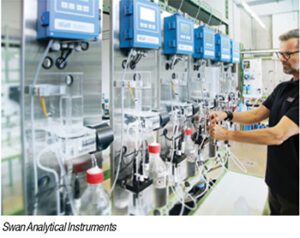 This company’s analytical instruments (photo) are dedicated to continuous water monitoring and provide a flexible, customized solution to comply with the monitoring needs of a wide range of water-treatment facilities. The range includes single components or complete, panel-mounted instruments with the possibility of individual customization. Rigorous quality controls and tests on an in-house wet bench ensure that strict criteria and standards are met. Hall 11.1, Stand C15 — Swan Analytical Instruments AG, Hinwil, Switzerland
This company’s analytical instruments (photo) are dedicated to continuous water monitoring and provide a flexible, customized solution to comply with the monitoring needs of a wide range of water-treatment facilities. The range includes single components or complete, panel-mounted instruments with the possibility of individual customization. Rigorous quality controls and tests on an in-house wet bench ensure that strict criteria and standards are met. Hall 11.1, Stand C15 — Swan Analytical Instruments AG, Hinwil, Switzerland
A specialized flowmeter for hydrocarbon processing
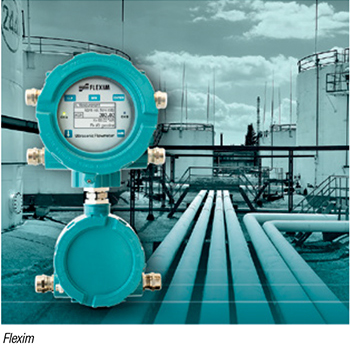 Designed for use in hydrocarbon processing applications, the Fluxus H831 ultrasonic flowmeter (photo) combines highly precise non-invasive measurement of volume flow and sound speed with advanced calculation features. It is approved for operation in ATEX/IECEx zone 1. Flow measurement is carried out non-intrusively with ultrasonic transducers mounted on the outside of the pipe. Fluxus H831 has two intrinsically safe (Ex-ia) process inputs for connecting pressure and temperature sensors. This allows the transmitter to directly determine API gravity, operational density, density at base conditions and kinematic viscosity. Temperature and pressure compensation allows for precise, standard volume-flow measurement of liquid hydrocarbons. Typical applications for the Fluxus H831 are mass balance, leak and interface detection, product identification in tank farms and oil terminals, quality checks and verification or temporary replacement of stationary measuring devices. Hall 11.1, Stand A16 — Flexim GmbH, Berlin, Germany
Designed for use in hydrocarbon processing applications, the Fluxus H831 ultrasonic flowmeter (photo) combines highly precise non-invasive measurement of volume flow and sound speed with advanced calculation features. It is approved for operation in ATEX/IECEx zone 1. Flow measurement is carried out non-intrusively with ultrasonic transducers mounted on the outside of the pipe. Fluxus H831 has two intrinsically safe (Ex-ia) process inputs for connecting pressure and temperature sensors. This allows the transmitter to directly determine API gravity, operational density, density at base conditions and kinematic viscosity. Temperature and pressure compensation allows for precise, standard volume-flow measurement of liquid hydrocarbons. Typical applications for the Fluxus H831 are mass balance, leak and interface detection, product identification in tank farms and oil terminals, quality checks and verification or temporary replacement of stationary measuring devices. Hall 11.1, Stand A16 — Flexim GmbH, Berlin, Germany
A new line of low-pulsation rotary-piston pumps
This company is launching a new rotary-piston pump that is energy efficient, low in pulsation and hermetically sealed, combining the advantages of other well-known pumping technologies. The pump’s design, in which the torque of the outer shaft is transmitted to the pistons by magnets, reduces the pump’s maintenance requirements. The new pumps can handle toxic, corrosive or viscous liquids, and are suitable for conveying shear-sensitive and explosive materials. Hall 8.0, Stand C1 — Paul Bungartz GmbH & Co. KG, Düsseldorf, Germany
Process technologies to support circularity
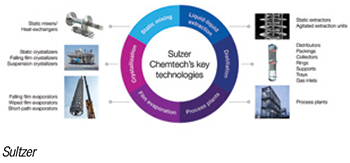 This company will showcase its comprehensive mass-transfer portfolio (photo), process technology solutions, technology licensing and engineering capabilities, placing a particular focus on sustainable production and circular strategies. This will feature a virtual reality (VR) area, where visitors will be able to explore full-scale photorealistic reproductions of real-world processing and manufacturing facilities that leverage the company’s equipment. Users will be able to learn how plants can maximize throughput, product quality and energy efficiency, driving their productivity and sustainability. The group will also showcase purification technologies that help to address challenges in plastic recycling and upcycling processes. Hall 4.0, Stand D48 — Sulzer Ltd., Winterthur, Switzerland
This company will showcase its comprehensive mass-transfer portfolio (photo), process technology solutions, technology licensing and engineering capabilities, placing a particular focus on sustainable production and circular strategies. This will feature a virtual reality (VR) area, where visitors will be able to explore full-scale photorealistic reproductions of real-world processing and manufacturing facilities that leverage the company’s equipment. Users will be able to learn how plants can maximize throughput, product quality and energy efficiency, driving their productivity and sustainability. The group will also showcase purification technologies that help to address challenges in plastic recycling and upcycling processes. Hall 4.0, Stand D48 — Sulzer Ltd., Winterthur, Switzerland
A new generation of extruders for laboratory use
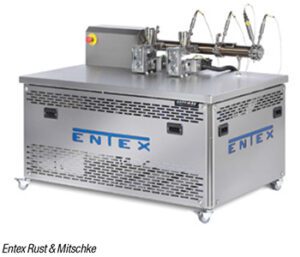 This company has expanded its range of modular extruders with a new planetary roller extruder for laboratory use, the 30 Series (photo). This unit’s size makes it possible to perform series of tests for formulation and product development at laboratory scale. The design features of the new extruder mean that the advantages of other extruder models — absolute temperature control, capabilities to mix active substances, low-shear thin-layer rolling-out and large surface exchange — can now be applied in material-critical areas in quantities of several hundred grams per hour. Hall 4.0, Stand B8 — Entex Rust & Mitschke, GmbH, Bochum, Germany
This company has expanded its range of modular extruders with a new planetary roller extruder for laboratory use, the 30 Series (photo). This unit’s size makes it possible to perform series of tests for formulation and product development at laboratory scale. The design features of the new extruder mean that the advantages of other extruder models — absolute temperature control, capabilities to mix active substances, low-shear thin-layer rolling-out and large surface exchange — can now be applied in material-critical areas in quantities of several hundred grams per hour. Hall 4.0, Stand B8 — Entex Rust & Mitschke, GmbH, Bochum, Germany
This microreactor is designed for electrochemistry scaleup
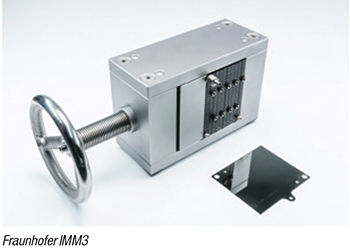 This organization has developed a flexible and scaleable microreactor for electrochemical conversions (photo). Parallel arranged electrodes, small distance between the electrodes, and their operation under laminar flow conditions lead to homogeneous and beneficial process conditions overcoming limitations linked to conventional electrosyntheses. The reactor concept, based on a plate-stack design approach, allows not only the operation of one electrochemical cell in various configurations, but also the extension to a larger number of cells for scaleup. Now, this expansion approach has been validated through an application of Kolbe electrolysis increasing the number of cells in the stack up to four. Starting from fatty acids obtainable from biomass, Kolbe electrolysis allows the synthesis of valuable chemicals. Envisioned is a further increase up to 20 cells corresponding to a production capacity of about 3 kg/h of production. Hall 9.1, Stand E64 — Fraunhofer Institute for Microengineering and Microsystems (IMM), Mainz, Germany
This organization has developed a flexible and scaleable microreactor for electrochemical conversions (photo). Parallel arranged electrodes, small distance between the electrodes, and their operation under laminar flow conditions lead to homogeneous and beneficial process conditions overcoming limitations linked to conventional electrosyntheses. The reactor concept, based on a plate-stack design approach, allows not only the operation of one electrochemical cell in various configurations, but also the extension to a larger number of cells for scaleup. Now, this expansion approach has been validated through an application of Kolbe electrolysis increasing the number of cells in the stack up to four. Starting from fatty acids obtainable from biomass, Kolbe electrolysis allows the synthesis of valuable chemicals. Envisioned is a further increase up to 20 cells corresponding to a production capacity of about 3 kg/h of production. Hall 9.1, Stand E64 — Fraunhofer Institute for Microengineering and Microsystems (IMM), Mainz, Germany
This series of explosion-proof pumps has been expanded
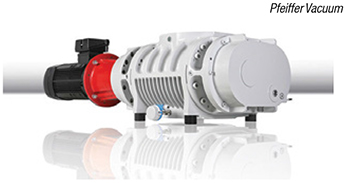 This company has expanded its OktaLine range of Roots pumps (photo), which are designed for use in potentially explosive environments or for evacuating explosive gases. Designed in accordance with the ATEX Directive (2014/34/EU1 or 1999/92/EC) with pressure surge resistance of PN 16, they meet the highest explosion protection requirements. Zone entrainment of explosive gases is ruled out as a result. Due to the expansion of the series, pumping speeds range from 280 to 8,100 m 3/h. Depending on the application, there is a choice between equipment category 2G or 3G. All pumps are suitable for temperature class T3. Installation is possible without flame arresters. This means that the full pumping speed of the pump is effectively available. The pumps are suitable for universal use due to their variable differential-pressure and flexible rotational speed. All pumps can be used at ambient temperatures ranging from –20 to 40°C. Hall 8.0, Stand J37 — Pfeiffer Vacuum GmbH, Asslar, Germany
This company has expanded its OktaLine range of Roots pumps (photo), which are designed for use in potentially explosive environments or for evacuating explosive gases. Designed in accordance with the ATEX Directive (2014/34/EU1 or 1999/92/EC) with pressure surge resistance of PN 16, they meet the highest explosion protection requirements. Zone entrainment of explosive gases is ruled out as a result. Due to the expansion of the series, pumping speeds range from 280 to 8,100 m 3/h. Depending on the application, there is a choice between equipment category 2G or 3G. All pumps are suitable for temperature class T3. Installation is possible without flame arresters. This means that the full pumping speed of the pump is effectively available. The pumps are suitable for universal use due to their variable differential-pressure and flexible rotational speed. All pumps can be used at ambient temperatures ranging from –20 to 40°C. Hall 8.0, Stand J37 — Pfeiffer Vacuum GmbH, Asslar, Germany
Expanded flow-chemistry range for a large span of flows
With the recent acquisition of Alconbury Weston Ltd. (AWL), this company has expanded its continuous-processing capabilities and bridged a crucial gap in flow chemistry. Combining the newly acquired technologies with existing capabilities enables the group to tackle complex processing issues, including continuous reactions, crystallization processes that have a high crystal concentration, and continuous drying and filtration processes at all production scales, from laboratory and research to commercial. The company will be highlighting an engineered facility that demonstrates the working steps from continuous reaction, crystallization, filtration and drying to the mixing process and dosing into the final packaging. Hall 12.0, Stand A21 — Dec Group SA, Lausanne, Switzerland
This flexible atomizer simplifies spray-drying operations
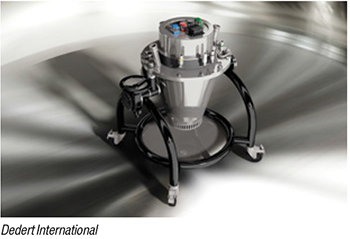 The patent-pending Air Bearing Atomizer (ABA; photo) provides low-maintenance operation for spray-drying applications. Conceptually, a thin film of pressurized air “levitates” the shaft of the rotary atomizer, yielding a virtually frictionless operation with true alignment while eliminating wear parts. Unlike established air-bearing technology, this new technology’s efficiency and effectiveness is due to a proprietary air distribution mechanism. The system is oil- and contact-free and runs on utility air level, meaning that no lubrication system is necessary. The permanent-magnet-motor technology is 95% efficient with high power levels and high disc-tip speeds. The atomizer has only one moving part, which eliminates premature wear, reduces spare parts and lowers maintenance requirements, such as bearing-changes. In addition, a rotating maintenance stand is provided for ease of servicing and cleaning. The units are available in three sizes to meet a full range of industrial spray-dryer capacities: ABA-25 (25 kW), ABA-100 (100 kW) and ABA-300 (300 kW). Hall 4.0, Stand G3 — Dedert International A/S, Ballerup, Denmark
The patent-pending Air Bearing Atomizer (ABA; photo) provides low-maintenance operation for spray-drying applications. Conceptually, a thin film of pressurized air “levitates” the shaft of the rotary atomizer, yielding a virtually frictionless operation with true alignment while eliminating wear parts. Unlike established air-bearing technology, this new technology’s efficiency and effectiveness is due to a proprietary air distribution mechanism. The system is oil- and contact-free and runs on utility air level, meaning that no lubrication system is necessary. The permanent-magnet-motor technology is 95% efficient with high power levels and high disc-tip speeds. The atomizer has only one moving part, which eliminates premature wear, reduces spare parts and lowers maintenance requirements, such as bearing-changes. In addition, a rotating maintenance stand is provided for ease of servicing and cleaning. The units are available in three sizes to meet a full range of industrial spray-dryer capacities: ABA-25 (25 kW), ABA-100 (100 kW) and ABA-300 (300 kW). Hall 4.0, Stand G3 — Dedert International A/S, Ballerup, Denmark
Multifunctional flowmeters that are extremely compact
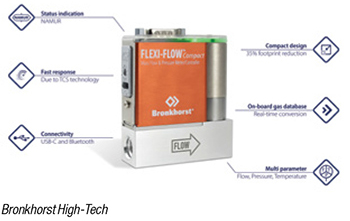 The Flexi-Flow thermal mass flowmeter (photo) combines the advantages of a unique through-chip-sensor with proven bypass technology. The compact meters and controllers are 35% smaller than traditional instruments, making them the smallest on the market for flow ranges up to 20 l n /min, says the company. The instruments feature very stable flow control, but also very fast control, with settling times smaller than 150 ms. Flexi-Flow instruments have integrated temperature and pressure sensors and an onboard gas database for high accuracy, even at varying process conditions. The instruments are adaptable to many applications due to their wide dynamic flow ranges. The temperature and pressure signals may provide the user with information about the actual process conditions, making the meters capable of multiparameter measurement and control. Hall 11.1, Stand F3 — Bronkhorst High-Tech BV, Ruurlo, the Netherlands
The Flexi-Flow thermal mass flowmeter (photo) combines the advantages of a unique through-chip-sensor with proven bypass technology. The compact meters and controllers are 35% smaller than traditional instruments, making them the smallest on the market for flow ranges up to 20 l n /min, says the company. The instruments feature very stable flow control, but also very fast control, with settling times smaller than 150 ms. Flexi-Flow instruments have integrated temperature and pressure sensors and an onboard gas database for high accuracy, even at varying process conditions. The instruments are adaptable to many applications due to their wide dynamic flow ranges. The temperature and pressure signals may provide the user with information about the actual process conditions, making the meters capable of multiparameter measurement and control. Hall 11.1, Stand F3 — Bronkhorst High-Tech BV, Ruurlo, the Netherlands
Continuous monitoring of thin-film evaporators
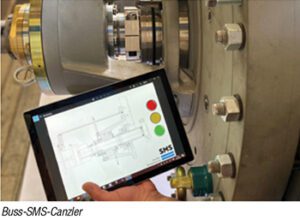 This company offers predictive maintenance solutions for mechanical seals and bearings on thin-film evaporators (photo, p. 52). The predictive-maintenance platform includes an early warning system to enable optimized availability with minimal downtime. Status information can be transmitted to mobile phones so that personnel can remotely check equipment. Hall 4.0, Stand B24 — Buss-SMS-Canzler GmbH, Butzbach, Germany
This company offers predictive maintenance solutions for mechanical seals and bearings on thin-film evaporators (photo, p. 52). The predictive-maintenance platform includes an early warning system to enable optimized availability with minimal downtime. Status information can be transmitted to mobile phones so that personnel can remotely check equipment. Hall 4.0, Stand B24 — Buss-SMS-Canzler GmbH, Butzbach, Germany
Valve actuators for extremely harsh environments
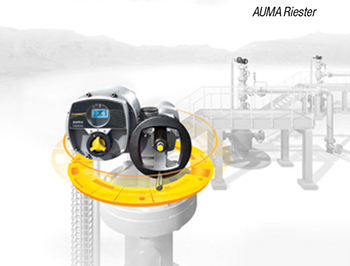 High-performance Tigron valve actuators (photo) meet the requirements of demanding applications, from petroleum production, storage and transport to downstream processing. They are ATEX and IECEx certified for the highest gas group IIC T4, which includes hydrogen. Other approvals are also in progress. A wide temperature range from –65 to 75°C, IP68 protection and an extremely resistant powder coating ensure that Tigron devices operate safely and reliably in harsh environments. The smart actuators are available in different sizes and combinations to suit all valve automation tasks, including high-precision operation of control valves and choke valves. Operation via magnetic pen is available for extreme conditions. A commissioning assistant makes setting up easy and safe. Tigron actuators provide non-intrusive setup without requiring additional tools for commissioning. In hard-to-reach locations, or where vibration is a problem, the controls can be mounted separately from the actuator. Hall 8.0, Stand C23 — AUMA Riester GmbH & Co. KG, Müllheim, Germany
High-performance Tigron valve actuators (photo) meet the requirements of demanding applications, from petroleum production, storage and transport to downstream processing. They are ATEX and IECEx certified for the highest gas group IIC T4, which includes hydrogen. Other approvals are also in progress. A wide temperature range from –65 to 75°C, IP68 protection and an extremely resistant powder coating ensure that Tigron devices operate safely and reliably in harsh environments. The smart actuators are available in different sizes and combinations to suit all valve automation tasks, including high-precision operation of control valves and choke valves. Operation via magnetic pen is available for extreme conditions. A commissioning assistant makes setting up easy and safe. Tigron actuators provide non-intrusive setup without requiring additional tools for commissioning. In hard-to-reach locations, or where vibration is a problem, the controls can be mounted separately from the actuator. Hall 8.0, Stand C23 — AUMA Riester GmbH & Co. KG, Müllheim, Germany
Durable fluoropolymers with a wide processing window
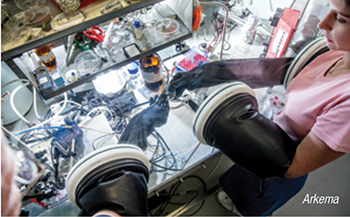 This company’s flagship fluoropolymer resins — the Kynar range — are designed for excellent durability and resistance to aggressive chemicals, radiation, sunlight and ultraviolet light. The polyvinylidene difluoride (PVDF) resins are especially suited for the ever-growing semiconductor applications market (photo). With rigid, flexible and highly flexible grades available, Kynar PVDF resins provide a balance of mechanical properties and melt processability for a wide range of process applications. Hall 9.1, Stand A31 — Arkema S.A., Colombes, France
This company’s flagship fluoropolymer resins — the Kynar range — are designed for excellent durability and resistance to aggressive chemicals, radiation, sunlight and ultraviolet light. The polyvinylidene difluoride (PVDF) resins are especially suited for the ever-growing semiconductor applications market (photo). With rigid, flexible and highly flexible grades available, Kynar PVDF resins provide a balance of mechanical properties and melt processability for a wide range of process applications. Hall 9.1, Stand A31 — Arkema S.A., Colombes, France
Single-use separators eliminate cleaning requirements
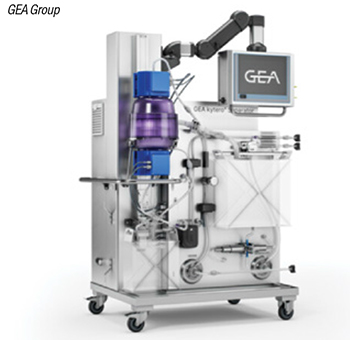 The kytero single-use pharma separator (photo) provides high separation efficiency, simple and safe handling and the elimination of costly cleaning procedures. With its maximized separation efficiency, yields up to 98% and gentle product handling, kytero systems enable new ways for processing cell-culture-based fermentations in pilot plants, laboratories and small-scale biopharmaceutical production facilities. As the systems rely on disk separators, the use of filtration is significantly reduced. The kytero 500 was developed for a capacity of up to 150 L/h and is thus suitable for laboratories and small batches. For scaleup applications, another model will soon become available, says the manufacturer. The gentle feed system preserves the vitality of shear-sensitive products. With the single-use separators, all product-contacting parts are replaced after use, preventing any cross-contamination without the need for cleaning and sterilization. The frictionless drive system provides 100% biocontainment by eliminating the need for seals or mechanical bearings. Setup and changeover time (only 5 to 10 min for preparation) is minimal. No auxiliary equipment, such as water, buffers or tanks, is required. Hall 4.0, Stand G66 — GEA Group, Düsseldorf, Germany
The kytero single-use pharma separator (photo) provides high separation efficiency, simple and safe handling and the elimination of costly cleaning procedures. With its maximized separation efficiency, yields up to 98% and gentle product handling, kytero systems enable new ways for processing cell-culture-based fermentations in pilot plants, laboratories and small-scale biopharmaceutical production facilities. As the systems rely on disk separators, the use of filtration is significantly reduced. The kytero 500 was developed for a capacity of up to 150 L/h and is thus suitable for laboratories and small batches. For scaleup applications, another model will soon become available, says the manufacturer. The gentle feed system preserves the vitality of shear-sensitive products. With the single-use separators, all product-contacting parts are replaced after use, preventing any cross-contamination without the need for cleaning and sterilization. The frictionless drive system provides 100% biocontainment by eliminating the need for seals or mechanical bearings. Setup and changeover time (only 5 to 10 min for preparation) is minimal. No auxiliary equipment, such as water, buffers or tanks, is required. Hall 4.0, Stand G66 — GEA Group, Düsseldorf, Germany
These battery-operated forklifts are now IECEx-certified
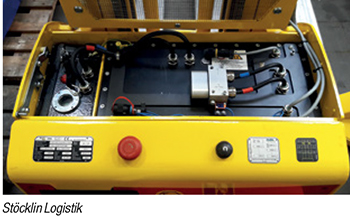 Last December, the Ex forklift series, equipped with LiTex batteries (photo), received the IECEx safety certification for safe operation in potentially explosive environments, including in gas (Zone 1) and dust atmospheres (Zone 21). Following the 2018 launch of LiTex — the world’s first lithium-ion battery for use in Ex-protected environments — this new certification is a key prerequisite for Korean Certification (KC), which is required in Asian markets. The explosion-proof LiTex battery can be charged at any time in the ATEX zone, just like a normal Li-ion battery, which increases efficiency and availability of equipment. In the past, users had to leave the explosion-proof room or even the shop floor to charge the battery. As charging usually takes around 8 h, batteries had to be changed during shift operation in order to continue working. This significant loss of time is eliminated by LiTex’s pressurized charger. According to the company, a battery life cycle of at least 5,000 full cycles is guaranteed. Hall 9.1, Stand A59 — Stöcklin Logistik AG, Laufen, Switzerland
Last December, the Ex forklift series, equipped with LiTex batteries (photo), received the IECEx safety certification for safe operation in potentially explosive environments, including in gas (Zone 1) and dust atmospheres (Zone 21). Following the 2018 launch of LiTex — the world’s first lithium-ion battery for use in Ex-protected environments — this new certification is a key prerequisite for Korean Certification (KC), which is required in Asian markets. The explosion-proof LiTex battery can be charged at any time in the ATEX zone, just like a normal Li-ion battery, which increases efficiency and availability of equipment. In the past, users had to leave the explosion-proof room or even the shop floor to charge the battery. As charging usually takes around 8 h, batteries had to be changed during shift operation in order to continue working. This significant loss of time is eliminated by LiTex’s pressurized charger. According to the company, a battery life cycle of at least 5,000 full cycles is guaranteed. Hall 9.1, Stand A59 — Stöcklin Logistik AG, Laufen, Switzerland
An overfill protection valve for underground storage tanks
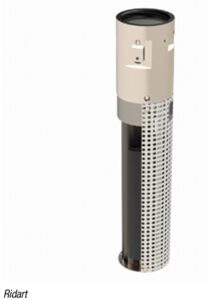 This company offers a wide range of brass, aluminum and stainless-steel safety valves for use in petrochemicals facilities. The company’s Model 442 overfill protection valve (photo) is designed to prevent the overfill of storage tanks by providing a positive shutoff of product delivery. The shutoff valve is an integral part of the drop tube used for gravity filling. The Model 442 is certified as a two-stage shutoff valve. When the liquid level rises to about 95% of the tank capacity, the valve mechanism is released, closing automatically with the flow. The operator may then stop the filling process and disconnect and drain the delivery hose. As long as the liquid exceeds the 95% level, the valve will close automatically each time delivery is attempted. If the delivery is not stopped and the liquid rises to about 98% of tank capacity, the bypass valve closes completely. No additional liquid can flow into the tank until the level drops below a reset point. Hall 9.0, Stand A30 — Ridart S.r.l., Gazzada Schianno, Italy
This company offers a wide range of brass, aluminum and stainless-steel safety valves for use in petrochemicals facilities. The company’s Model 442 overfill protection valve (photo) is designed to prevent the overfill of storage tanks by providing a positive shutoff of product delivery. The shutoff valve is an integral part of the drop tube used for gravity filling. The Model 442 is certified as a two-stage shutoff valve. When the liquid level rises to about 95% of the tank capacity, the valve mechanism is released, closing automatically with the flow. The operator may then stop the filling process and disconnect and drain the delivery hose. As long as the liquid exceeds the 95% level, the valve will close automatically each time delivery is attempted. If the delivery is not stopped and the liquid rises to about 98% of tank capacity, the bypass valve closes completely. No additional liquid can flow into the tank until the level drops below a reset point. Hall 9.0, Stand A30 — Ridart S.r.l., Gazzada Schianno, Italy
This system can be adapted to count tablets or gummy products
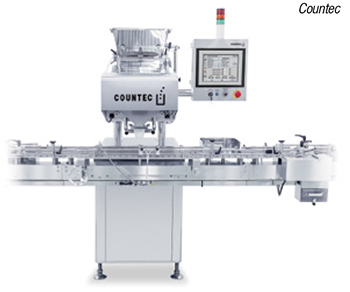 The DMC Series is an automatic tablet/capsule counting machine (photo) that can be equipped with special parts and devices and modified to become a counter for gummy products. By replacing the hopper and tray for the gummy, it is possible to count and fill both conventional tablets and gummy products with a single counting machine. The adaptable gummy-exclusive tray features an embossed stainless-steel surface to improve the flowability of the gummy product, and a special agitator installed in the hopper helps to loosen any clumped gummy products and separate them one by one. When compared to a typical checkweighing system, a designated counting machine can increase productivity because loss rate is reduced. Hall 3.1, Stand G69 — Countec Ltd., Gyeonggi-Do, South Korea
The DMC Series is an automatic tablet/capsule counting machine (photo) that can be equipped with special parts and devices and modified to become a counter for gummy products. By replacing the hopper and tray for the gummy, it is possible to count and fill both conventional tablets and gummy products with a single counting machine. The adaptable gummy-exclusive tray features an embossed stainless-steel surface to improve the flowability of the gummy product, and a special agitator installed in the hopper helps to loosen any clumped gummy products and separate them one by one. When compared to a typical checkweighing system, a designated counting machine can increase productivity because loss rate is reduced. Hall 3.1, Stand G69 — Countec Ltd., Gyeonggi-Do, South Korea
Crossflow filters ensure high product quality and yield
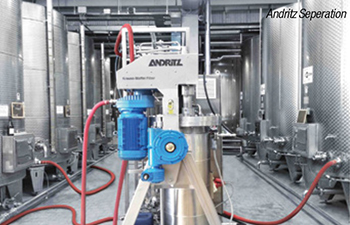 The Krauss-Maffei dynamic crossflow filter (DCF; photo) is suitable for the clarification of liquids and for concentrating and washing of solids in a broad variety of chemical and biochemical products. Whether the targeted products are solid or liquid, the Krauss-Maffei DCF increases yield and product quality. The filters offer extremely high yields and can process highly concentrated suspensions up to a viscosity of 7,000 mPa·s. Product quality is assured due to the DCF’s single-pass filtration concept, short residence times and the elimination of gas contact. Higher permeate flux means that a smaller installed equipment footprint is required. Hall 12.0, Stand C19 — Andritz Separation GmbH, Graz, Austria
The Krauss-Maffei dynamic crossflow filter (DCF; photo) is suitable for the clarification of liquids and for concentrating and washing of solids in a broad variety of chemical and biochemical products. Whether the targeted products are solid or liquid, the Krauss-Maffei DCF increases yield and product quality. The filters offer extremely high yields and can process highly concentrated suspensions up to a viscosity of 7,000 mPa·s. Product quality is assured due to the DCF’s single-pass filtration concept, short residence times and the elimination of gas contact. Higher permeate flux means that a smaller installed equipment footprint is required. Hall 12.0, Stand C19 — Andritz Separation GmbH, Graz, Austria
Continuous casting for membranes, films and more
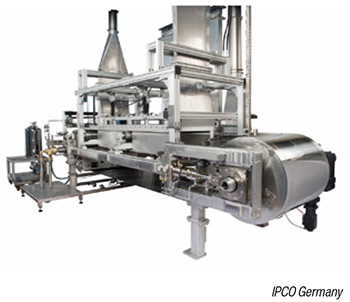 This company offers continuous film-casting systems (photo) for the production of membranes, separators, ceramic tapes and optical films. The systems use a stainless-steel belt to transport a layer of liquid product through a series of carefully controlled sections. This involves heat and mass transfer in the evaporation process or a controlled phase-separation process in a precipitation section. Once these processes have been completed, the solid formed or transformed product is removed from the belt. At this stage, the product will be either in final or intermediate form; the latter requiring further processing, such as post-drying, leaching or stretching. Key benefits include ultra-efficient continuous production, the ability to cast very thin films to fine tolerances and producing high-quality microporous membranes. A pilot film-casting line with a Venturi dryer module and a conventional impingement-dryer section is available for customer trials at the company’s productivity center in Fellbach, Germany. The unit features a winding and unwinding unit and is capable of handling water- or solvent-based casting solutions. Hall 4.0, Stand D4 — IPCO Germany GmbH, Fellbach, Germany
This company offers continuous film-casting systems (photo) for the production of membranes, separators, ceramic tapes and optical films. The systems use a stainless-steel belt to transport a layer of liquid product through a series of carefully controlled sections. This involves heat and mass transfer in the evaporation process or a controlled phase-separation process in a precipitation section. Once these processes have been completed, the solid formed or transformed product is removed from the belt. At this stage, the product will be either in final or intermediate form; the latter requiring further processing, such as post-drying, leaching or stretching. Key benefits include ultra-efficient continuous production, the ability to cast very thin films to fine tolerances and producing high-quality microporous membranes. A pilot film-casting line with a Venturi dryer module and a conventional impingement-dryer section is available for customer trials at the company’s productivity center in Fellbach, Germany. The unit features a winding and unwinding unit and is capable of handling water- or solvent-based casting solutions. Hall 4.0, Stand D4 — IPCO Germany GmbH, Fellbach, Germany
A flexible tablet press for laboratory-scale test runs
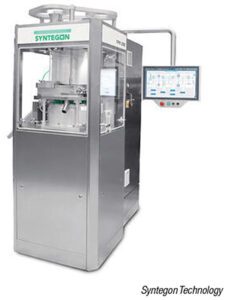 The TPR 200 Plus tablet press (photo) offers efficient processing for various granules and pellets. It also features a light containment concept with dust-tight machine protection up to Occupational Exposure Band (OEB) 3. Besides the production of small and medium-sized batches, the compact system supports the development of continuous tablet production. When combined with the company’s Solidlab 2 Plus system, the TPR 200 Plus is particularly suitable for laboratory-scale test runs and subsequent scaleup. The automatically adjustable powder feeder with automated process-development software allows users to define the optimal parameters for the formulation feed going into the die. The new system also allows users to improve existing processes and increase the product yield and quality in tablet production. Process efficiency benefits from an integrated data-acquisition system, which assesses tablet quality and process stability. Hall 3.1, Stand C71 — Syntegon Technology GmbH, Crailsheim, Germany
The TPR 200 Plus tablet press (photo) offers efficient processing for various granules and pellets. It also features a light containment concept with dust-tight machine protection up to Occupational Exposure Band (OEB) 3. Besides the production of small and medium-sized batches, the compact system supports the development of continuous tablet production. When combined with the company’s Solidlab 2 Plus system, the TPR 200 Plus is particularly suitable for laboratory-scale test runs and subsequent scaleup. The automatically adjustable powder feeder with automated process-development software allows users to define the optimal parameters for the formulation feed going into the die. The new system also allows users to improve existing processes and increase the product yield and quality in tablet production. Process efficiency benefits from an integrated data-acquisition system, which assesses tablet quality and process stability. Hall 3.1, Stand C71 — Syntegon Technology GmbH, Crailsheim, Germany
A showcase for PtX and other “green” technologies
This company will be presenting a wide range of “green” technologies and optimized plant-design concepts, including new approaches for the conversion of renewable energies into fuels and basic products — known generally as power-to-X or PtX technologies. In particular, this company will showcase its work on what is said to be the world’s first industrial-scale PtX plant for the production of 50,000 ton/yr of kerosene. In addition to PtX, the company offers several other process technology platforms, including: biomass-to-X, which supports the utilization of biomass and biomethane; bio-silicates production from rice-husk feedstock; and a patented plastics recycling process for thermal depolymerization of polyolefinic materials. The company also operates a Water Competence center that helps users to minimize the water and energy consumption of their engineering systems. Hall 9.1, Stand B3 — Pörner Ingenieurgesellschaft GmbH, Vienna, Austria
Dry products gently and reliably at low temperatures
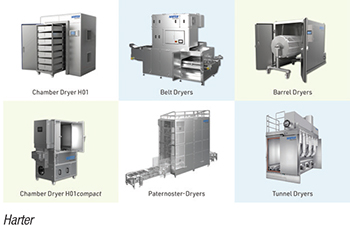 This company has developed the Airgenex heat-pump-based condensation drying system (photo), which combines seemingly contradictory features, such as short drying times and low temperatures. Upon completion of the drying cycle, the products are completely dry or dehumidified to the desired dry matter content, as specified. Drying takes place at a defined temperature between 20 and 90° C, which is beneficial to both personnel and products. These dryers use a closed air system. As the constancy of parameters is safely ensured, the process is independent of any environmental conditions. With minor modifications, the system may also be used for cooling to become a combined drying-cooling type if desired or required by the specific process. Additional non-compressed air blowing to remove sizeable amounts of water is also offered. The dryers may be used for both batch and continuous processes. Hall 3.1, Stand H48 — Harter GmbH, Stiefenhofen, Germany
This company has developed the Airgenex heat-pump-based condensation drying system (photo), which combines seemingly contradictory features, such as short drying times and low temperatures. Upon completion of the drying cycle, the products are completely dry or dehumidified to the desired dry matter content, as specified. Drying takes place at a defined temperature between 20 and 90° C, which is beneficial to both personnel and products. These dryers use a closed air system. As the constancy of parameters is safely ensured, the process is independent of any environmental conditions. With minor modifications, the system may also be used for cooling to become a combined drying-cooling type if desired or required by the specific process. Additional non-compressed air blowing to remove sizeable amounts of water is also offered. The dryers may be used for both batch and continuous processes. Hall 3.1, Stand H48 — Harter GmbH, Stiefenhofen, Germany
This digital twin platform simplifies data transfer and integration for retrofit projects
This company’s EB Alliance concept supports digital-twin integration with seamless data exchange between operators and suppliers who have each set up their own environments within the Engineering Base platform. EB Alliance also enables outsourcing and consistent reintegration of a digital twin of rebuild projects within an operating plant, no matter how complex. According to the company, EB Alliance allows all data to be mapped to the configuration state of the recipient, so that errors or misunderstandings do not occur in the first place. Additionally, the ability to hand over the digital twin of a plant section that is to be retrofit or expanded, as well as integrating it consistently into the new as-built state once the work is done, can also significantly speed up retrofit and maintenance projects. Hall 11.0, Stand C51 — Aucotec AG, Isernhagen, Germany